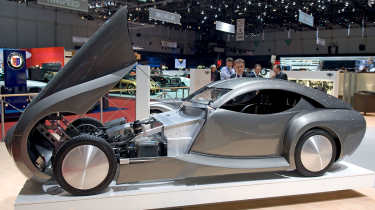Morgan lifecar
Hydrogen fuel-cell-driven concept revealed at Geneva Motor Show
Britain’s oldest and most famous maker of retro (or retro-inspired) sports cars revealed this blueprint for the future at the Geneva motor show in March. The design of the LifeCar, as it is called, tells you that it could have come from no other company but Morgan, yet with its fuel-cell power unit and ultra-lightweight construction it’s just the sort of sports car we might be driving in a decade’s time.
‘Everyone talks about the need to save weight, but Morgan has always built lightweight sports cars,’ says LifeCar designer Matthew Humphries. ‘Light weight makes a car fun to drive because you can fling it into corners, and you need less power to make it go well. People appreciate that now, like they appreciate minimal architecture.’
The LifeCar is a joint project between Morgan, technology company RiverSimple, Cranfield University and Oxford University. RiverSimple’s Hugo Spowers had the original idea as part of the company’s research into environmentally sound transport, while Cranfield handled the powertrain control and simulations and Oxford the motors and electronics. Morgan built the car at its factory in Malvern, Worcestershire, with CAD design and scanning tools incongruously sharing floor space with the company’s rather older fabrication techniques.
Humphries did the original sketches and clay model, which was scanned and made into CAD data from which a wooden buck was created. Then David Cale, one of Morgan’s master metalworkers, hand-built all the panels on the buck. ‘Doing it that way, like Sir William Lyons used to do at Jaguar, you get a tension you don’t get with clay,’ says Humphries.
‘We wanted a CdA [aerodynamic drag coefficient multiplied by frontal area] of 0.37,’ he continues, ‘so we had to make it narrow while keeping the signature of a Morgan. The LifeCar also gives a styling direction for the company. The long, flowing surfaces have a tension in them, a fresh look for the younger generation.’
While the fabricated aluminium chassis and hand-formed aluminium panels are what you’d expect in a Morgan, what makes it go is not. There are four electric motors, one for each wheel, which immediately brings the possibility of variable torque distribution, yaw controls and adjustable stability systems. The motors are powered by a QinetiQ four-stack fuel cell mounted ahead of the front bulkhead and fed by hydrogen from a tank in the car’s tail.
Fuel cells are quite slow to react to changing load demands, so most fuel-cell cars also carry batteries to give an extra surge of energy for acceleration. These are recharged by capturing energy when slowing and braking, but are heavy and not good at giving or receiving very powerful bursts of energy. An alternative is to use ultracapacitors, which can charge and discharge very quickly, and the LifeCar has a bank of them in its centre tunnel. They can provide or absorb up to 1000 amps very quickly, giving excellent acceleration (calculations suggest 0-60mph in under 7sec) and powerful regenerative braking, with stops of up to 0.7g (the conventional hydraulic brake system seldom has much to do). Top speed is reckoned to be about 100mph in short bursts, with a range on a tankful of hydrogen of between 150 and 250 miles.
Could this be the starting point for a real future Morgan? Some aspects of the design are clearly impractical. There are no doors, for example, so you get in by hinging the clamshell roof rearwards and leaping over the side. If the exterior is a futuristic take on Morgan traditions, the cabin is even more so. People expect wood in a Morgan, but not used like this. The dashboard, floor, seats and headrests are formed from one huge, lightweight piece of moulded veneered-plywood laminate, providing the shape and springing in one go. Leather pads soften the pressure points.
So, can we expect future Morgans to be like this? ‘We have made the decision to go with future emissions regulations,’ says Humphries, which means the 130g/km EU CO2 average-emissions target is on Morgan’s radar. The engineering solutions suggested by the LifeCar will help achieve it.





